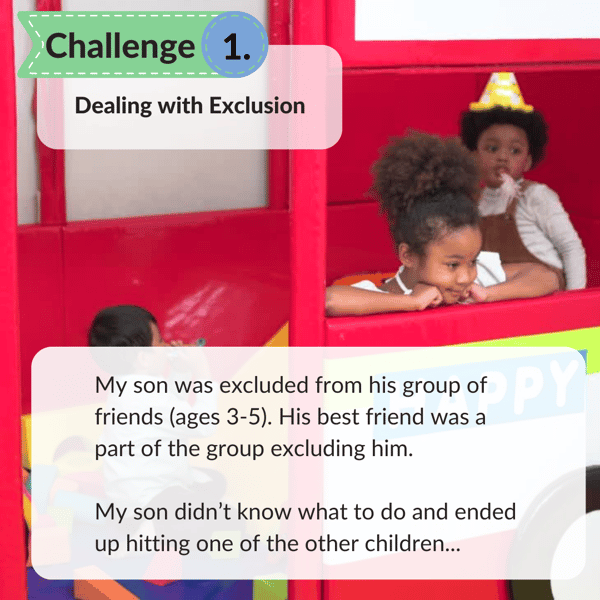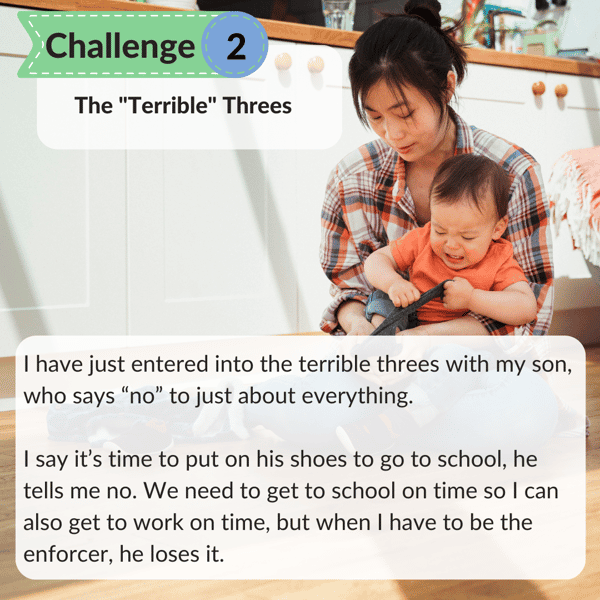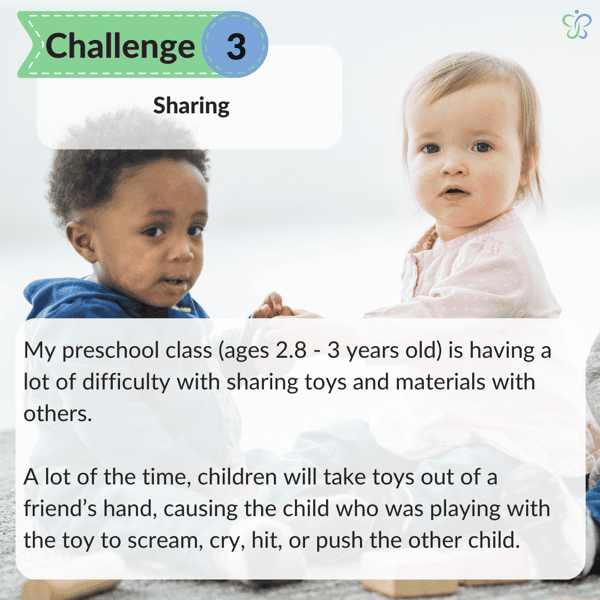
In this blog, we will respond to common challenges (exclusion, "terrible" threes, and sharing) that teachers and families are facing with children at school and at home to show you how to apply these ECSEL strategies on your own.
In the last blog, we went over teaching practices from ECSEL educators. We’d like to apply these practices to real-life challenges that real educators and caregivers are experiencing with children right now. So, let’s see how these strategies can be adjusted to meet current needs.
“My son was excluded from his group of friends (ages 3-5). His best friend was a part of the group excluding him. My son didn’t know what to do and ended up hitting one of the other children. The situation was resolved when he told the group that he didn’t want to play with them anymore, which ended up causing them to want to play with him after all.”

Unfortunately, children can be fickle at times and exclusion is a part of that. It’s important to provide your son with validation and reassurance and help him navigate the many big feelings that come with being excluded from play. As children grow, their relationships with peers will grow and change with them, which can look a lot like testing boundaries and exploring different social dynamics like excluding others. We understand that it can be heartbreaking for parents and caregivers to hear what your child is going through and not be there to “fix it,” but while we cannot control the behaviors of others, we can make sure that children have the strategies they need to deal with all of the emotions that friendships can bring up.
For a situation like this, ensure that your child feels heard when he shares his experience with you. Validate his feelings by letting him know that exclusion is not okay and doesn’t feel good, and you are here to talk with him about it. Together, the two of you can talk about things that help him to feel better when he feels sad, angry, or lonely, and what he could to express those feelings that doesn’t involve hurting others, such as finding an adult to help, using words to share what he is feeling, or taking space away from his friends. Practice those strategies together so he has tools to reach for if a moment like this happens again at school.
 Reading books about characters who experience exclusion or exclude others is another great way for children to feel seen and less alone in these moments. Books, such as The Not So Friendly Friend by Christina Furnival, are another great way to explore this challenge out of the heat of the moment. As you read together, you can ask your child what he notices about the feelings each character experiences, what causes those feelings to happen, and how characters express their feelings and resolve the conflict.
Reading books about characters who experience exclusion or exclude others is another great way for children to feel seen and less alone in these moments. Books, such as The Not So Friendly Friend by Christina Furnival, are another great way to explore this challenge out of the heat of the moment. As you read together, you can ask your child what he notices about the feelings each character experiences, what causes those feelings to happen, and how characters express their feelings and resolve the conflict.
If you are reading this as an educator navigating exclusion or difficult social dynamics in your classroom, it is helpful to have similar heat-of-the-moment strategies on hand to diffuse the situation. When you notice exclusion happening, bring the children together once they are calm and guide them to share what each one is feeling and the cause to help build some empathy and perspective-taking around the situation.
It is important to understand that the goal is not for everyone to feel happy, but to create an environment where everyone feels heard and can reach a solution together. You can also continue to build empathy through storytelling with the whole class. Find stories that highlight exclusion and the feelings that come with it. As you read, ask children if they have ever experienced exclusion and how that made them feel. Brainstorm games and ideas as a group that involves everyone.
Main ECSEL Takeaways:
|
“I have just entered into the terrible threes with my son, who says “no” to just about everything. He ignores the rules and pushes just about every boundary. I know in my head that he is trying to assert his independence, but I’m also having a hard time navigating the meltdowns that follow any boundaries I set. For example, if I say it’s time to put on his shoes to go to school, he tells me no. We need to get to school on time so I can also get to work on time, but when I have to be the enforcer, he loses it.”

Ah, every parent and teacher’s favorite phase. But you are absolutely right — all of the “no”s are a completely developmentally appropriate way for your child to assert independence and test boundaries. However, knowing this does not make it any less frustrating to navigate!
First thing's first: make sure you have your own strategies in place to help you feel grounded and regulated in these moments. There will always be situations when we are rushing around or running late and hearing “no” can feel like the last straw, but just remember: your child is learning and looking to you for what happens next. Whether it’s taking a deep breath, closing your eyes, or taking some space away if you can, make sure you are regulated before responding to your child.
Something that can really help you avoid a power struggle is to offer your child a choice. This doesn’t mean backpedaling on your boundaries but giving your child agency within those boundaries.
Let’s use your example: “If I say it’s time to put your shoes on and go to school, he tells me no.” This is the start of a power struggle and will escalate both your child's feelings and yours. You can keep the boundary and expectation that you need to leave for school and shoes need to be on, but there is still plenty of room for choice here.
For example, if you notice your child moving slowly and still does not have their shoes on, you can say: “It’s time for school and I see you don’t have your shoes on yet! Are you going to put on your light-up shoes or striped shoes? Are you going to put your left one on first, or the right? Do you want to put them on by the door or outside by the car?”
Offering choices gives your child the sense of control they are craving in the moment and avoids the need for you to slip into the dreaded role of “enforcer.” Positively reinforce the choices your child makes in the right direction, and eventually, they will feel empowered enough to make these choices on their own!
Main ECSEL Takeaways:
|
“My preschool class (ages 2.8 - 3 years old) is having a lot of difficulty with sharing toys and materials with others. They have a very egocentric mentality and often say that everything is “mine,” and have meltdowns when it’s time for a friend’s turn. A lot of the time, children will take toys out of a friend’s hand, causing the child who was playing with the toy to scream, cry, hit, or push the other child. I have tried explaining to the class that they need to share, but it doesn’t seem to be helping. I’m dealing with similar reactions whenever they don’t get what they want, which happens constantly in the classroom.”

Sharing can already be a challenge for children even under normal circumstances, but factoring in the toll the pandemic has had on children’s emotional and social development makes it that much more challenging. We know firsthand how difficult, frustrating, and exhausting it can be to navigate sharing, and we want to validate those feelings for teachers everywhere.
Finding ways to teach empathy and guide children to practice prosocial skills out of the heat of the moment can help lay the foundation for skills and behaviors we want to see more of, like sharing. One way to do this is by modeling sharing one on one. This can happen during circle time, during storytime, playtime, or even snack times — something as simple as, “I have two pieces of paper and I would really love for you to draw with me, so I’m going to share with you!” Doing this often enough sets an example for children’s behaviors and actions throughout the day.
On the other side of this, be sure to acknowledge and make a big deal when you notice acts of sharing independently. Responses like, “Wow, that was a really kind thing to do! You are such a caring friend, thank you for sharing,” can positively reinforce this behavior.
Another way to approach sharing is seeing it as a transition: you have the toy and now it’s time to give it to someone else. Transitions can be hard for anyone, but especially for children who are still learning to regulate their emotions.
Setting a timer for taking turns is one strategy that can help to ease this transition. With a sand timer or digital timer, children are given a visual reminder of the passing of time. Within this time, they can prepare to wrap up their idea and pass the toy to their friend with teacher guidance and reminders.
If feelings still escalate, let children know that you understand it’s hard to share when we don’t want to and they are allowed to feel angry. Keep the boundary while supporting the child with regulating their big feelings with a hug, deep breaths, taking space, or choosing a different calm activity.
Main ECSEL Takeaways
|
It’s important to note that no child is the same, making no solution one-size-fits-all. We wish it were that simple, but as teachers, parents, and caregivers, one thing that we’re used to doing is adjusting. Adjusting to the individual needs of children, to different developmental milestones, and to the many challenges that life throws our way. Again, we may not have all the answers, but we hope that these ECSEL takeaways can provide you with some peace of mind and strategies to get started.
Don't Miss #AskDrDonna📢 Have questions of your own, or want more advice from an expert child psychologist and her team of Early Childhood Educators? Follow us on Instagram to hear Dr. Donna and her team answer real questions! Feel free to send us your questions in the comments!
|
Housman Institute, LLC
831 Beacon Street, Suite 407
Newton, MA 02459
info@housmaninstitute.org
(508)379-3012
Explore
Our Products
Legal
Connect
Contact
Join our Mailing List!
Subscribe to receive our newsletter, latest blogs, and ECSEL resources.
We respect and value your privacy.
Comments (1)